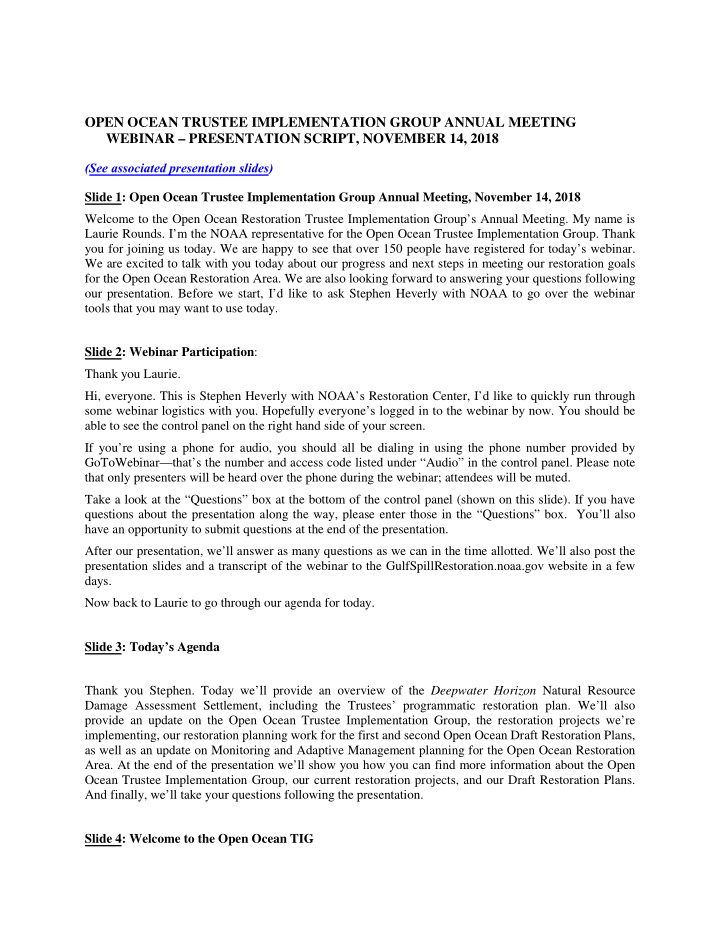



OPEN OCEAN TRUSTEE IMPLEMENTATION GROUP ANNUAL MEETING WEBINAR – PRESENTATION SCRIPT, NOVEMBER 14, 2018 (See associated presentation slides) Slide 1: Open Ocean Trustee Implementation Group Annual Meeting, November 14, 2018 Welcome to the Open Ocean Restoration Trustee Implementation Group’s Annual Meeting. My name is Laurie Rounds. I’m the NOAA representative for the Open Ocean Trustee Implementation Group. Thank you for joining us today. We are happy to see that over 150 people have registered for today’s webinar. We are excited to talk with you today about our progress and next steps in meeting our restoration goals for the Open Ocean Restoration Area. We are also looking forward to answering your questions following our presentation. Before we start, I’d like to ask Stephen Heverly with NOAA to go over the webinar tools that you may want to use today. Slide 2: Webinar Participation : Thank you Laurie. Hi, everyone. This is Stephen Heverly with NOAA’s Restoration Center, I’d like to quickly run through some webinar logistics with you. Hopefully everyone’s logged in to the webinar by now. You should be able to see the control panel on the right hand side of your screen. If you’re using a phone for audio, you should all be dialing in using the phone number provided by GoToWebinar—that’s the number and access code listed under “Audio” in the control panel. Please note that only presenters will be heard over the phone during the webinar; attendees will be muted. Take a look at the “Questions” box at the bottom of the control panel (shown on this slide). If you have questions about the presentation along the way, please enter those in the “Questions” box. You’ll also have an opportunity to submit questions at the end of the presentation. After our presentation, we’ll answer as many questions as we can in the time allotted. We’ll also post the presentation slides and a transcript of the webinar to the GulfSpillRestoration.noaa.gov website in a few days. Now back to Laurie to go through our agenda for today. Slide 3: Today’s Agenda Thank you Stephen. Today we’ll provide an overview of the Deepwater Horizon Natural Resource Damage Assessment Settlement, including the Trustees’ programmatic restoration plan. We’ll also provide an update on the Open Ocean Trustee Implementation Group, the restoration projects we’re implementing, our restoration planning work for the first and second Open Ocean Draft Restoration Plans, as well as an update on Monitoring and Adaptive Management planning for the Open Ocean Restoration Area. At the end of the presentation we’ll show you how you can find more information about the Open Ocean Trustee Implementation Group, our current restoration projects, and our Draft Restoration Plans. And finally, we’ll take your questions following the presentation. Slide 4: Welcome to the Open Ocean TIG
Before we provide an overview of the BP settlement, I’d like to introduce the members of the Open Ocean Trustee Implementation Group. The Open Ocean Trustee Implementation Group, referred to as a TIG, is one of seven Gulf of Mexico Restoration Areas established to conduct restoration for the Deepwater Horizon Natural Resource Damage Assessment. The four federal natural resource trustees are the members of this TIG, and we work together to plan and implement restoration for fish, sturgeon, sea turtles, marine mammals, birds, and deep sea communities injured by the 2010 BP oil spill. All of our work will be consistent with the programmatic restoration plan finalized by the Trustee Council in April 2016, which we’ll talk about later in the presentation. The Open Ocean TIG will also coordinate with the five Gulf state trustees, especially when restoration will overlap state jurisdictions. The representatives for the Open Ocean TIG are Chris Doley and Laurie Rounds for the National Oceanic and Atmospheric Administration or NOAA; Ron Howard and Mark Defley for the U.S. Department of Agriculture; Gale Bonanno and Treda Grayson for the U.S. Environmental Protection Agency; and Kevin Reynolds and Ashley Mills for the Department of the Interior. Slide 5: DWH Natural Resource Damage Assessment and BP Settlement Next, Gale Bonanno with the US EPA will provide an overview of the Deepwater Horizon Natural Resource Damage Assessment and BP Settlement. Slide 6: BP NRDA Settlement Thank you, Laurie. In 2016, the Deepwater Horizon Natural Resource Trustees reached a settlement resulting from the Natural Resource Damage Assessment process (abbreviated NRDA) to resolve BP’s liability for natural resource injuries caused by the Deepwater Horizon oil spill. Part of the settlement requires BP to pay $8.8 billion dollars to federal and state trustees for the purposes of restoring natural resources and the services they provide that were injured by the spill. The settlement will be paid out incrementally over the course of 15 years – the first payment was made in 2017. Based on the kind and extent of injuries caused by the spill, the $8.8 billion has been allocated among the Trustees’ five broad restoration goals as indicated in the slide. These goals are to restore and conserve habitat, replenish and protect coastal and marine resources, restore water quality, provide and enhance recreational opportunities, and support monitoring, adaptive management, and administrative oversight across the TIGs. Slide 7: Programmatic Restoration Plan In advance of the final settlement, the federal and state trustees developed the programmatic restoration plan. The plan provides a detailed description of the injury assessment which concluded that the scale of the injury was so massive, an ecosystem approach to restoration is needed. The Trustees’ integrated ecosystem planning approach to address this injury is also detailed in the plan. The Trustees’ plan is called a “programmatic plan” because, rather than identifying individual restoration projects, it identifies the goals, types and approaches for restoration that set the course for more detailed, future project-level planning. The plan also establishes a governance structure – basically, how the Trustees will work together and with the public to develop and implement projects over time. 2
Recommend
More recommend